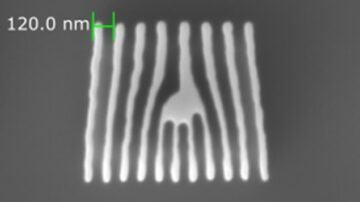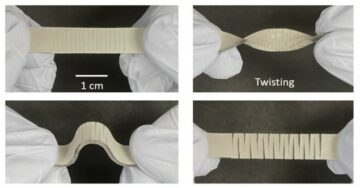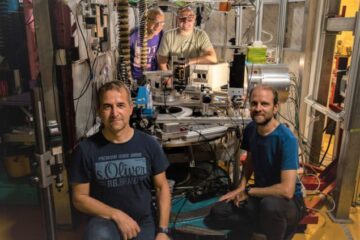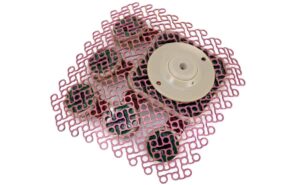
After 30 years of painstaking development, researchers in Germany and New Zealand have unveiled a laser gyroscope that can track fluctuations in Earth’s rotation in near real time and accurate to several milliseconds. The technique is much simpler than current methods and could provide further insights into phenomena that cause the fluctuations – such as shifts in ocean currents.
The Earth rotates once in one day, but there are tiny fluctuations in the rate and direction of our planet’s rotation. Some of these fluctuations are well understood – for example those caused by the tidal forces of the Moon and Sun.
Other tiny fluctuations are not well understood including those related to the exchange of momentum between the solid Earth and the oceans, atmosphere and ice sheets. These effects can arise from climate events such as the El Niño southern oscillation, which change ocean currents. As a result, measuring fluctuations in Earth’s rotation could shed light on important processes in the atmosphere.
Combined measurements
Most rotation studies involve combining data from global satellite navigation systems; very long baseline radio-astronomy observations of quasars; and laser ranging. Due to the complexity of combining these techniques, only one measurement can be made per day.
Now, a team headed by Ulrich Schreiber at the Technical University of Munich has created a laser gyroscope that can measure the tiny fluctuations in near real time. What is more, their instrument can fit into a large room.
At its heart is an optical cavity that guides light around a square path that is 16 m long. A pair of laser beams are sent around the cavity in opposite directions creating a ring laser gyroscope. This works on the principle that a rotation of the gyroscope affects the interference pattern that is created when the two beams are combined at a detector. Such gyroscopes are used in onboard inertial navigation systems in some aircraft and submarines.
Basement laboratory
“In contrast to other techniques [for measuring Earth’s rotation], our ring laser is self-contained and can fit into our basement laboratory, allowing us to instantaneously read the Earth’s rotation almost in real time,” Schreiber explains. “Now, after 30 years of experimental effort, we have succeeded in recovering the signal of interest.”
To reach this point, the team needed to fine-tune five key aspects of the laser gyroscope’s operation. First, the instrument needed to be sensitive enough to resolve variations as subtle as 3 ppb of Earth’s rotational velocity. In fact, this was one of the easiest challenges they faced, and could be overcome simply by making the gyroscope 16 m in length.
From here, the team’s task only became more difficult. “The sensor needed to be extremely stable,” Schreiber said about the second challenge. “We cannot allow it to develop a drift because even the tiniest lack of stability would generate an apparent signal, which would drown our effort entirely. The stability has been the hardest part to achieve.”
Elaborate error correction
The third task the team tackled was how to deal with the errors introduced by the varying orientation of Earth’s rotational axis. These were addressed using an elaborate error correction method.
“The next problem is that we only have a single gyro component, but three spatial directions,” Schreiber continues. “This means we need to track the tilt of our instrument to the level of 3 nrad, which is a tiny, tiny angle. A change in orientation causes the projection of the earth rotation vector to change, which is nothing else than a drift and that is a false signal.”
Finally, the gyroscope’s dual laser beams do not operate completely independently of each other. This means that the gyroscope’s measurements can drift in the long term. To counteract this problem, the team have spent years developing a laser dynamics model that can recognise and scrub out any drift in the gyroscope’s readings.

Optical gyroscope on a chip can detect Earth’s rotation
Now, following decades of hard work, the team’s instrument controls all five of these factors at the same time – allowing it to monitor Earth’s rotation rate to a resolution of just a few milliseconds over 120 days.
Having passed this impressive milestone, Schreiber’s team is now able to track variations in the length of the day both continuously and real time. This could help to provide deeper insights into how the solid Earth exchanges momentum with the air, water, and ice on its surface.
Looking further ahead, the researchers now aim to extend their gyroscope’s stability even further. “This will enable us to capture the seasonal effect of these momentum transfers,” says Schreiber. “At the moment, we can only look at the prominent signals with a period of roughly 14 days, so there are still a number of challenges ahead of us.”
The research is described in Nature Photonics.
- SEO Powered Content & PR Distribution. Get Amplified Today.
- PlatoData.Network Vertical Generative Ai. Empower Yourself. Access Here.
- PlatoAiStream. Web3 Intelligence. Knowledge Amplified. Access Here.
- PlatoESG. Carbon, CleanTech, Energy, Environment, Solar, Waste Management. Access Here.
- PlatoHealth. Biotech and Clinical Trials Intelligence. Access Here.
- Source: https://physicsworld.com/a/laser-gyroscope-measures-tiny-fluctuations-in-earths-rotation/
- :has
- :is
- :not
- 14
- 16
- 160
- 30
- a
- Able
- About
- accurate
- Achieve
- addressed
- After
- ahead
- aim
- AIR
- aircraft
- All
- allow
- Allowing
- an
- and
- any
- apparent
- ARE
- arise
- around
- AS
- aspects
- At
- Atmosphere
- Axis
- Baseline
- BE
- became
- because
- been
- between
- both
- but
- by
- CAN
- cannot
- capture
- Cause
- caused
- causes
- challenge
- challenges
- change
- chip
- click
- Climate
- combined
- combining
- completely
- complexity
- component
- continues
- continuously
- contrast
- controls
- could
- counteract
- created
- Creating
- Current
- data
- day
- Days
- deal
- decades
- deeper
- described
- detect
- develop
- developing
- Development
- difficult
- direction
- directions
- do
- due
- dynamics
- each
- earth
- easiest
- ed
- effect
- effects
- effort
- el
- Elaborate
- else
- enable
- enough
- entirely
- error
- Errors
- Even
- events
- example
- exchange
- Exchanges
- experimental
- Explains
- extend
- extremely
- faced
- fact
- factors
- false
- few
- First
- fit
- five
- fluctuations
- following
- For
- Forces
- from
- further
- generate
- Germany
- Global
- Guides
- Hard
- hard work
- Have
- headed
- Heart
- help
- here
- How
- How To
- HTTPS
- ICE
- image
- important
- impressive
- in
- Including
- independently
- information
- insights
- instantaneously
- instrument
- interest
- interference
- into
- introduced
- involve
- issue
- IT
- ITS
- jpg
- just
- Key
- laboratory
- Lack
- large
- laser
- Length
- Level
- light
- Long
- Look
- made
- Making
- max-width
- means
- measure
- measurement
- measurements
- measures
- measuring
- method
- methods
- milestone
- milliseconds
- model
- moment
- Momentum
- Monitor
- Moon
- more
- much
- Munich
- Navigation
- Near
- Need
- needed
- New
- New Zealand
- next
- nothing
- now
- number
- observations
- ocean
- oceans
- of
- on
- Onboard
- once
- ONE
- only
- open
- operate
- operation
- opposite
- Other
- our
- out
- over
- Overcome
- pair
- part
- passed
- path
- Pattern
- per
- period
- Physics
- Physics World
- plato
- Plato Data Intelligence
- PlatoData
- Point
- principle
- Problem
- processes
- Projection
- prominent
- provide
- ranging
- Rate
- reach
- Read
- real
- real-time
- recognise
- recovering
- related
- research
- researchers
- Resolution
- result
- Ring
- Room
- roughly
- Said
- same
- satellite
- says
- seasonal
- Second
- sensitive
- sent
- several
- shed
- Shifts
- Signal
- signals
- simply
- single
- So
- solid
- some
- Southern
- Spatial
- spent
- square
- Stability
- stable
- Still
- studies
- such
- Sun
- Surface
- Systems
- Task
- team
- Technical
- technique
- techniques
- term
- than
- that
- The
- their
- There.
- These
- they
- Third
- this
- those
- three
- thumbnail
- time
- to
- track
- transfers
- true
- two
- understood
- university
- unveiled
- us
- used
- using
- variations
- varying
- VeloCity
- very
- was
- Water
- we
- WELL
- were
- What
- What is
- when
- which
- will
- with
- Work
- works
- world
- would
- years
- Zealand
- zephyrnet












